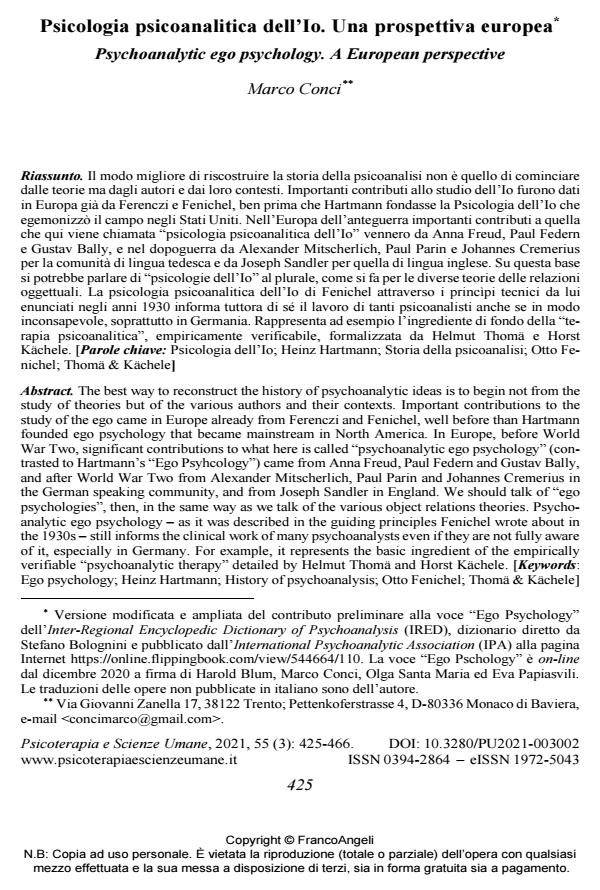Psicologia psicoanalitica dell’Io. Una prospettiva europea
Titolo Rivista PSICOTERAPIA E SCIENZE UMANE
Autori/Curatori Marco Conci
Anno di pubblicazione 2021 Fascicolo 2021/3
Lingua Italiano Numero pagine 42 P. 425-466 Dimensione file 549 KB
DOI 10.3280/PU2021-003002
Il DOI è il codice a barre della proprietà intellettuale: per saperne di più
clicca qui
Qui sotto puoi vedere in anteprima la prima pagina di questo articolo.
Se questo articolo ti interessa, lo puoi acquistare (e scaricare in formato pdf) seguendo le facili indicazioni per acquistare il download credit. Acquista Download Credits per scaricare questo Articolo in formato PDF

FrancoAngeli è membro della Publishers International Linking Association, Inc (PILA)associazione indipendente e non profit per facilitare (attraverso i servizi tecnologici implementati da CrossRef.org) l’accesso degli studiosi ai contenuti digitali nelle pubblicazioni professionali e scientifiche
Il modo migliore di riscostruire la storia della psicoanalisi non è quello di cominciare dalle teorie ma dagli autori e dai loro contesti. Importanti contributi allo studio dell’Io furono dati in Europa già da Ferenczi e Fenichel, ben prima che Hartmann fondasse la Psicologia dell’Io che egemonizzò il campo negli Stati Uniti. Nell’Europa dell’anteguerra importanti contributi a quella che qui viene chiamata "psicologia psicoanalitica dell’Io" vennero da Anna Freud, Paul Federn e Gustav Bally, e nel dopoguerra da Alexander Mitscherlich, Paul Parin e Johannes Cremerius per la comunità di lingua tedesca e da Joseph Sandler per quella di lingua inglese. Su questa base si potrebbe parlare di "psicologie dell’Io" al plurale, come si fa per le diverse teorie delle relazioni oggettuali. La psicologia psicoanalitica dell’Io di Fenichel attraverso i princìpi tecnici da lui enunciati negli anni 1930 informa tuttora di sé il lavoro di tanti psicoanalisti anche se in modo inconsapevole, soprattutto in Germania. Rappresenta ad esempio l’ingrediente di fondo della "terapia psicoanalitica", empiricamente verificabile, formalizzata da Helmut Thomä e Horst Kächele.
Parole chiave:Psicologia dell’Io; Heinz Hartmann; Storia della psicoanalisi; Otto Fenichel; Thomä & Kächele
- Psychoanalytic ego psychology: A European perspective Marco Conci, in International Forum of Psychoanalysis /2023 pp.4
DOI: 10.1080/0803706X.2022.2128210 - Global vernetzte Psychoanalyse. Die International Federation of Psychoanalytic Societies (IFPS) zwischen 1960 und 1980 [A globally connected psychoanalysis. The International Federation of Psychoanalytic Societies (IFPS) between 1960 and 1980] Marco Conci, in International Forum of Psychoanalysis /2021 pp.247
DOI: 10.1080/0803706X.2021.2030128 - From psychoanalytic ego psychology to relational psychoanalysis, a historical and clinical perspective Marco Conci, Gabriele Cassullo, in International Forum of Psychoanalysis /2023 pp.1
DOI: 10.1080/0803706X.2023.2186002
Marco Conci, Psicologia psicoanalitica dell’Io. Una prospettiva europea in "PSICOTERAPIA E SCIENZE UMANE" 3/2021, pp 425-466, DOI: 10.3280/PU2021-003002